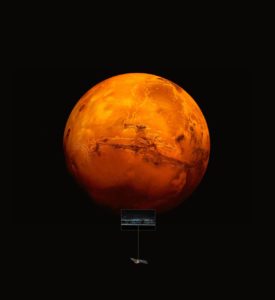Jul 26 2018
Water on Mars
 It looks like Mars has become the third body in the solar system that has a body of water beneath a cover of ice. As reported by AAAS:
It looks like Mars has become the third body in the solar system that has a body of water beneath a cover of ice. As reported by AAAS:
Between May 2012 and December 2015, the Mars Express spacecraft was used to conduct a radar survey of a region called Planum Australe, located in the southern ice cap of Mars. A tool onboard the spacecraft sends radar pulses that penetrate the surface and ice caps of the planet and reflections off subsurface features provide scientists with information about what lies below.
The scientists concluded that water was the best explanation for the radar images. This is far from confirmation, but it is a strong suggestion and certainly warrants follow up.
We have known for a long time that Mars used to be a watery planet, with flowing water on its surface. There are geological features that look like ancient river beds, for example. In order to have surface water, however, you need an atmosphere with enough pressure and warmth, so Mars likely had a thick enough atmosphere in the past. That atmosphere was lost over time, probably due to the steady pressure of the solar winds, without any significant magnetic field to protect from it (like we have on Earth).
There is also evidence for water on Mars today – there is a tiny amount of water vapor in the thin atmosphere. There is also permanent water ice in the ice caps on Mars. There is a transient and seasonal carbon dioxide ice layer in the north and a permanent carbon dioxide layer over the southern ice cap, but both are mostly water ice. In fact, if all the ice on Mars melted, it could cover the entire surface to a depth of 35 meters. Finally there is water ice in the surface soil on Mars, which occasionally boils away at the surface.
The question has been, however, is there a stable body of liquid water anywhere on Mars? In addition to simply understanding the geology of Mars better, this has been of keen interest because liquid water is a potential habitat for Martian microbes – life. That is why the current finding is so exciting.
But – there are some complications. First, we need to confirm that this radar signal is actually liquid water. Assuming it is, however, the temperature of that water will likely be between -10 and -60 degrees C. The reason water can get so cold without freezing is salt; salt water has a lower freezing temperature. To be that cold, the water would have to be really salty, what the scientists are calling a brine. The Martian soil has magnesium, calcium and sodium which could dissolve into any such water creating a thick slushy brine that could stay sort-of liquid at very low temperatures.
Could such a cold briny thick water harbor life? Sure. There are extremophiles on Earth living in the frigid lakes beneath the Antarctic icecap. Extremophiles can live off chemosynthesis – they can use the salts for energy, without the need for sunlight for photosynthesis. Potential life on Mars could have slowly evolved over billions of years to adapt to the changing climate. So the notion of Martian life is absolutely plausible, even if it is a long shot.
Unfortunately we will not be finding out anytime soon. The possible body of water lies beneath 1.5 km of ice. We would need to design, build, and send a robot (or perhaps multiple robots) to Mars that could drill beneath that ice to get samples. This is a similar situation to Europa, which also has liquid water beneath its icy surface that we would need to drill through to look for ice. Although Europa’s surface ice is 19-25 km thick, so that would be much more difficult.
In other words – Mars may have just gone to the top of the list in terms of possible locations for alien life in our solar system. Enceladus remains the other candidate, and could arguably still be at the top of the list. A Mars mission might be a lot easier, however.
Discovering life beyond Earth would be an enormous scientific discovery. One primary question is whether such life would be related to life on Earth. If it is, then it is likely that life was spread from one world to other worlds within our solar system. It is even possible life spread from Mars to Earth – we may all be descended from Martians. Far less likely is that life spread from outside our solar system to multiple locations within it, including the Earth.
It is also possible that life began on Mars or elsewhere completely independently from life on Earth. That would give us information about how common life is likely to be in the Universe. Right now we have a N of 1. Even just a second instance of life popping up would mean that life is likely not extremely rare. Right now we have no idea.
It would also be fascinating to see what completely alien life looks like. The possibilities are mind numbing, and this would open an entirely new field of biology.
This is a scientific project worth investing in. The international space community should be thinking right now about starting plans to get the equipment on Mars to follow up on this discovery. In the famous words of Arnold – “Get your ass to Mars.”






